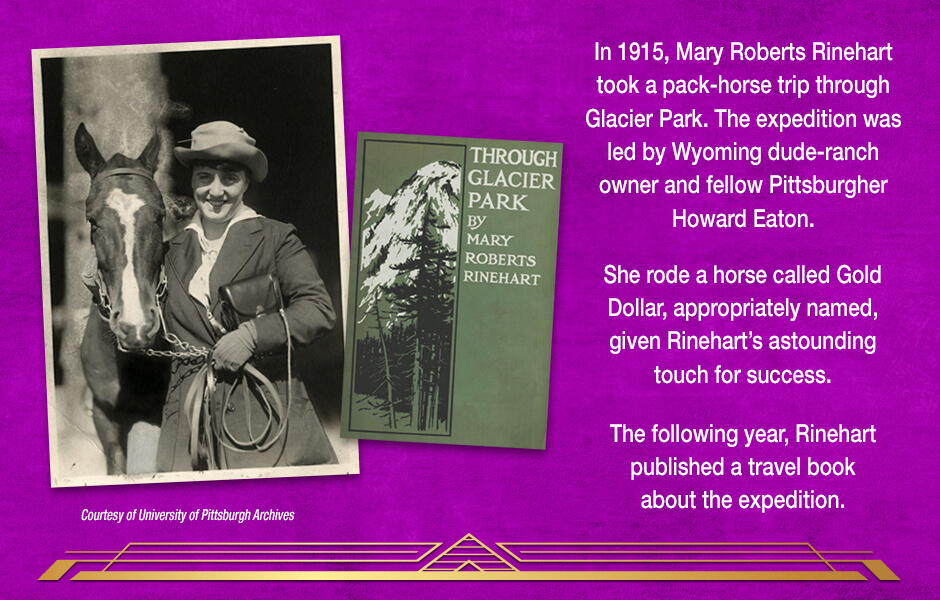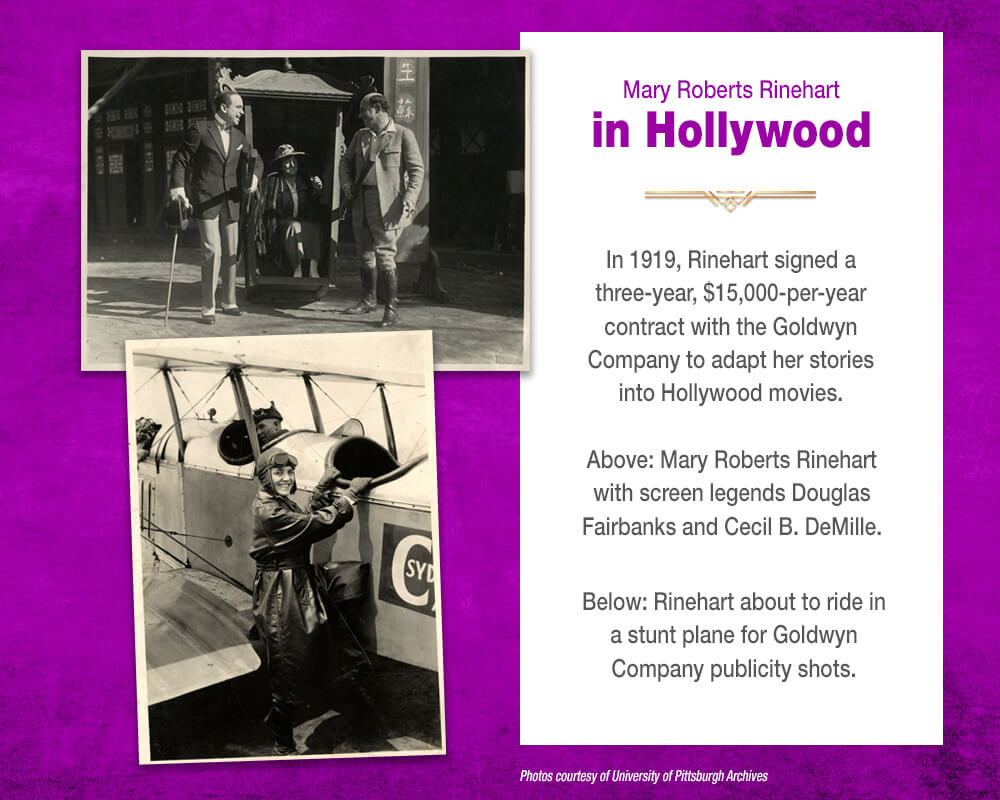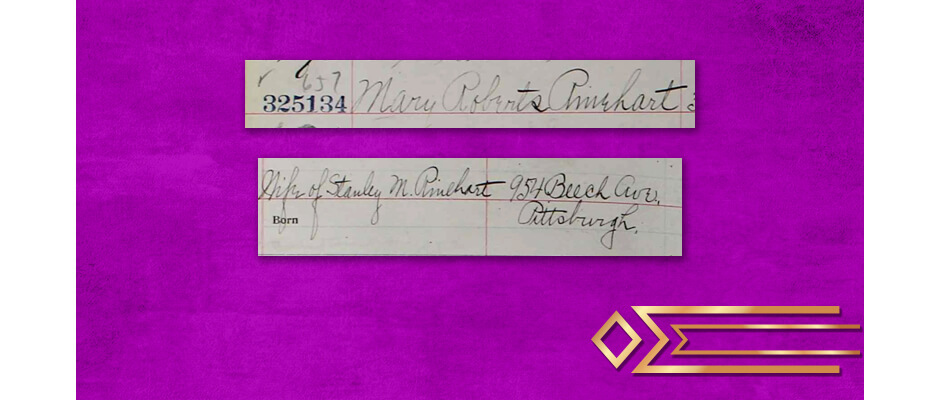Mary Roberts Rinehart

1876-1958
Mary Roberts Rinehart was a self-made multi-millionaire. She made her fortune through imagination and hard work as one of the most popular and prolific authors in America in the first half of the twentieth century. She published her first best-selling novel, The Circular Staircase, in 1908, at age 32. For the next four decades, she was the most successful female author in America.
Known as America's Agatha Christie, her specialty was deftly plotted mysteries and thrillers, interweaving suspense, humor and romance, and often incorporating vivid female characters as leads.
A Pittsburgh native, Rinehart grew up in Allegheny City (North Side), the eldest daughter of Thomas Beveridge and Cornelia Gilleland Roberts. The young family lived with Mary's paternal grandmother, a widow. Money was tight, and the house was full of extended family and a canary named Dicky. Mary's mother, a skilled seamstress, made all the clothing for her two daughters and took in extra work to help supplement the family's income.
Young Mary Roberts had a keen appetite for books. The local library at the time was in the office of the Allegheny City mayor, so it was there that Roberts went, borrowed her way through the entire juvenile section and then moved on to reading anything that interested her, which was a lot. She read Henry Morton Stanley's book about Africa. She consumed the high adventures of Alexandre Dumas and the realistic novels of Balzac. The characters of Dickens, Thackeray, Jules Verne and Victor Hugo became the companions of her imagination. The lessons of spellbinding storytelling she absorbed from the masters would serve her well in her own career.

At 17, Mary Roberts began training as a nurse at Pittsburgh's Homeopathic Hospital. There, she met a young physician, Stanley Marshall Rinehart, who was the younger half-brother of Dollar Bank teller Fred Rinehart. Roberts became a bride at 19, marrying Dr. Rinehart in April 1896. The wedding was celebrated quietly, since it followed just a few months after the untimely death of Mary's beloved father.
Mary Roberts Rinehart started writing after the birth of the first of her and Stanley's three sons. She began with small pieces penned for magazines. The sale of a few poems netted her twenty-two dollars. She wrote more poetry, earning modest sums. Her attempt to find a publisher for a book of children's verse, however, failed. Disheartened, Rinehart resolved to put her pen and paper away. But when a stock market crash put the family's finances in dire straits, Rineheart tried writing again -- this time, fiction. She sold a short story, a medical drama, to Munsey's Magazine, and was paid two cents a word for a grand total of thirty-four dollars. Encouraged by the editor of Munsey's, she tried her hand at more lucrative serials.

Thus came about the story that changed everything -- The Circular Staircase, a murder mystery which first appeared as a five-part serial in late 1907, then was published as a novel in 1908 by Indianapolis publisher Bobbs-Merrill. Rinehart received the news of her novel's acceptance in the most mundane circumstances -- at a butcher's stall in the Allegheny Market House, where the butcher set the phone out between steaks and sausages, while Stanley Rinehart read to his wife over the phone the telegram message from Indianapolis. The publisher's faith in the work was vindicated when Rinehart's tale of a middle-aged spinster, a country mansion and a puzzling crime became a runaway best-seller.
A string of successes followed at a blazing pace. The Man in Lower Ten (1909), When a Man Marries (1909), The Window at the White Cat (1910) and The Amazing Adventures of Letitia Carberry (1911) captured readers and reviewers alike. The White Cat mystery was "perfectly articulated, flawlessly logical, without a single loose end," read one review. Another reviewer marveled at Rinehart's versatility as a writer, praising her analytical skills, her complicated plotting and pervasive humor.
Clearly, Mary Roberts Rinehart had tapped a rich vein of audience enthusiasm. Newspaper stories abounded about the happily married physician's wife who also happened to be a best-selling mystery-romance-thriller novelist. The Rineharts' domesticity was as appealing to readers as the fame that had landed on the writer in the family.

A trained nurse, Mary Roberts Rinehart put her nursing skills and journalist's pen to use helping Allied troops in Europe in World War I. Due to her extensive travels throughout the American West, she was the only woman appointed to President Hoover's Western Land Commission in 1929. A breast cancer survivor, Mary Roberts Rinehart exerted her influence as a celebrity to advocate for awareness of the disease and to encourage women to have regular examinations.
Mary Roberts Rinehart and her husband lived in two homes in the Pittsburgh area. Their first house was on Beech Avenue on the North Side. After the success of The Circular Staircase, the Rineharts built a fine custom home in Glen Osborne, near Sewickley. In 1922, they moved to Washington, D.C., when Dr. Rinehart accepted a position with the Veterans Administration. While she took up the role of Washington hostess. Rinehart did not slow down her writing career. She negotiated stage and screen adaptations of her stories and, in 1931, published a memoir, My Story.
Over a writing career that spanned more than fifty years, Rinehart's novels, plays and screen adaptations garnered around $27 million in sales, or roughly half a billion dollars in today's money. All three Rinehart sons followed their mother into the literary world. Stanley Rinehart, Jr. and Frederick "Ted" Rinehart co-founded the publishing house Farrar & Rinehart. Allan Rinehart became a playwright and film producer.
When she died in 1958, Mary Roberts Rinehart left behind volumes of handwritten pages and notes on her work, business correspondence and contracts with Hollywood studios and Broadway producers, and photos of her family life and travels over the decades. Rinehart's sons donated her papers to the University of Pittsburgh.
Mary Roberts Rinehart opened a savings account at Dollar Bank in December 1909.
